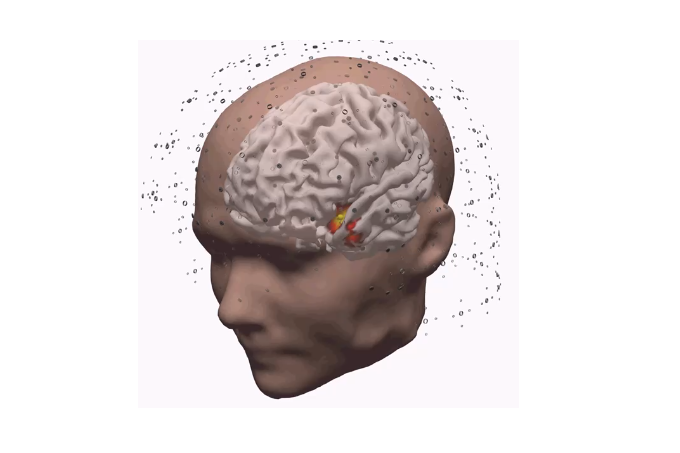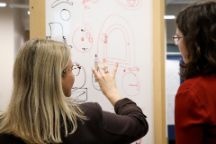The new non-invasive brain scan techniques giving seizure sufferers a new lease on life

Swinburne University of Technology’s cutting-edge non-invasive investigations for epilepsy are giving seizure sufferers a second chance at a happy and healthy life.
In summary
Stephenie Evans was told nothing could be done to address the cause of her daily seizures, until a revolutionary approach by Swinburne researchers transformed her life
The advanced technology-driven approach pinpoints problematic areas in the brain and avoids the risk of expensive and potentially dangerous invasive methods
Stephenie, who is available for interview, says the technique should give hope to 12,000 Australians diagnosed with epilepsy every year.
When Stephenie Evans suffered her first seizure in 2007, little did she know it was the start of a period where she was just “existing, not living”.
After becoming housebound with daily seizures, Stephenie was advised by her epilepsy specialist in Arizona, USA there was nothing more that could be done to help pinpoint which of the dozens of ‘cavernomas’ (abnormal blood vessel coils) in her brain were responsible for the seizures.
“The number of seizures I had completely impacted my quality of life and happiness. I didn't have a life anymore,” she says.
Thanks to Swinburne University of Technology’s cutting-edge non-invasive investigations for epilepsy, seizure sufferers like Stephenie Evans are being given a second chance at a happy and healthy life.

A technology-driven approach
Current invasive treatments techniques carry the risk of infection, bleeding and stroke, on top of a single depth electrode array that can cost over $1,000. Even then, it can be ineffective in identifying the culprit area in the brain.
Swinburne’s neuroimaging team is using 20 times more electrode sensors than standard hospital recordings. The high-resolution approach involves the use of combined high density electrical and magnetic field sampling with more than 400 sensor points across the head surface. This safe, non-invasive method more accurately pinpoints where the problematic abnormal brain waves are arising from.
Senior Neuroimaging Scientist and Swinburne Adjunct Research Fellow Simon Vogrin and Clinical Neurologist and Swinburne researcher Professor Chris Plummer worked with Stephenie after she got in an almost fatal car crash due to a seizure. Their study results were enough to convince the treating team that a particular cavernoma at the front of the brain should be removed.
“Patients with uncontrolled seizures are typically taking multiple types of medications that each carry side effects such as fatigue, drowsiness, dizziness, depression, and insomnia,” says Professor Plummer.
“Epilepsy surgery in cases like Stephenie remains vastly underused. One of the reasons is that it can be very difficult to pin-point the culprit regions in the brain that give rise to seizures using safe non-invasive tests. This is changing now with the advanced brain wave analysis techniques being employed at Swinburne. Surgery can literally transform lives.”
A new lease on life
More than two years have passed since the surgery was performed and Stephenie says the impact of the treatment has drastically improved her quality of life. “Without it, I would still be having seizures.”
Stephenie says Swinburne’s investigation has given her a life and hope for the future. She is able to drive, work, travel, and independently “do things everyone else takes for granted”.
“People need to know about this technique because in my case, it showed the one particular cavernoma causing my seizures, which was different than the standard hospital tests suggesting a different cavernoma.
“There is hope for people out there that think that there is nothing that can be done.”
-
Media Enquiries
Related articles
-

- Technology
- Science
- Engineering
Victorian students drive green energy transition through international hydrogen competition
Swinburne’s KIOSC, in collaboration with Horizon Educational and Gippsland Tech School, co-hosted the Hydrogen Grand Prix in Melbourne.Friday 26 July 2024 -

- Technology
- Health
New MedTechVic prototypes to transform everyday lives of people with a disability
Swinburne’s MedTechVic has revealed three new prototypes designed through the joint Health-led Manufacturing Innovation Program, in partnership with the Australian Medtech Manufacturing Centre and Safer Care Victoria
Friday 19 July 2024 -

- Science
Skin, scales and fish tails: using collagen to turn fish guts into gold
New research from Swinburne could transform the sector by converting high value collagen proteins from seafood by-products into cosmetics, food, and pharmaceuticals.
Tuesday 02 July 2024 -

- Science
- Engineering
Submarines in the future could self-identify cracks and self-heal thanks to Swinburne researcher
Thanks to the work of Dr Nisa Salim from Swinburne University of Technology’s School of Engineering, future submarines could self-identify microcracks and self-heal using a new kind of carbon fibre reinforced polymer composites.
Monday 17 June 2024 -

- Business
- Technology
Swinburne’s Luminate Pitch Night 2024 advances innovative ideas for a better world
Swinburne’s 2024 Luminate Pitch Night showcased market-ready ideas from 10 founders
Wednesday 12 June 2024

